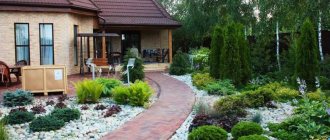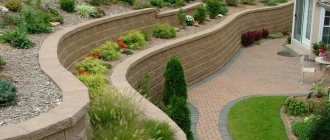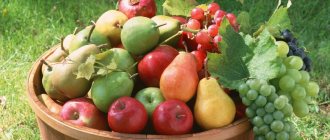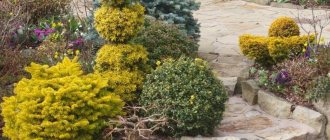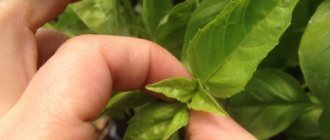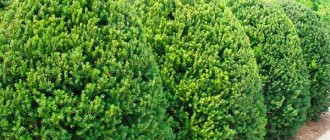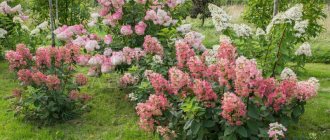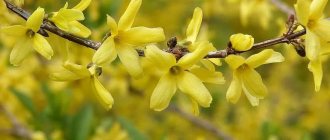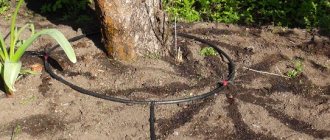Difference between shade-tolerant and shade-loving plants
The shade of individual areas of the garden is determined by the duration and intensity of their lighting during the day. The indicator varies depending on the time of day, season, the presence of deciduous trees and the density of their crown.
A plant located in the shade and, at the same time, having lush foliage, a healthy appearance, and bright flowers can be classified as shade-loving. Such crops decorate the lower tiers of coniferous and deciduous trees.
When a perennial grows worse in the shade than in the sun, then it is classified as a shade-tolerant variety that adapts to given conditions.
Shade-loving and shade-tolerant plants can get by with a small amount of light. The former are able to grow in areas with diffused or reflected light, where there is almost constant shade. The latter love sunny areas, with low light, subdued sun. Complete shade is unacceptable for them.
In order to correctly arrange flower beds of perennials in the shade, it is necessary to determine the degree of illumination and, based on this, select and plant.
Features of shadow areas
Almost every garden plot has places where shadow constantly falls.
But shaded areas vary depending on what the shade provides. Coniferous and deciduous trees create different conditions, as do various buildings and a solid fence. If the shadow comes from deciduous trees, then periodic formation of the crown will improve the situation, but the shadow from a house or fence cannot be changed in any way.
In addition, the shade creates its own microclimate and soil condition. For example, in a forest zone, the soil has a top coniferous litter, which allows air to pass through well and retains moisture. The soil is more acidic. Plus, ventilation is weaker, and the temperature due to the lack of sun is slightly lower than in the rest of the garden.
It is important to consider that shadows move throughout the day. Plants create bizarre light patterns; it will be interesting to play with this using landscaping.
Plants growing in the shade rarely have bright flowers; they have interesting textures and shapes, and variegated leaves.
Landscape designers recommend playing with contrasts and planting plants with dense leaves and thin, carved ones, emphasizing fragility and tenderness, and emphasizing unusual shapes.
Determining the degree of shady area
As mentioned above, shading varies. And it is caused by different objects. According to the degree of shading, areas in the garden differ into those that:
- receive full sunlight, but only for a couple of hours a day . This usually includes places that are in the shade near a fence or behind the house. The sun moves and casts light from different angles, so shadows may disappear in the morning or afternoon.
- buried in the openwork shade of trees, especially deciduous ones . In such places, light partial shade is created, plants can synthesize chlorophyll in sufficient quantities and practically do not experience a lack of sun.
- are in complete shade from any buildings , the soil remains moist, the temperature remains lower than in open areas, and little ventilation occurs;
- are in dry shade . This option is the most difficult to work with. This concept means that the soil in the shade does not receive light at all, plus the soil is dry with a minimum of moisture and nutrients. Typically, dry shade forms under deciduous trees with a shallow root system, for example, under birch trees. You will have to plant fast-growing and aggressive plants that quickly take over the territory, otherwise others will not survive in such conditions.
Dense, dense shadow
In an ordinary garden plot, such shade occurs under the canopy of old, often planted apple trees, on the north side of serviceberry bushes, hawthorn, and coniferous trees. Many gardeners find it difficult to select plants to decorate areas on the north side of the house. In such difficult conditions, you can also create interesting flower beds. The following plants will grow well here: elecampane, kupena, uvularia, various trilliums, arizema, ground cover plants such as cordifolia, sedum, and European hoofweed.
Hellebore will decorate a shady flower garden in spring. On the north side of the building, on clay, well-moistened soils, a flower garden looks great, which includes:
- spring flowering plants - oak anemones, hellebores, snowdrops, scillas;
- early summer blooming kupena, dark geranium, ozhiki, arizema;
- summer-flowering plants - Volzhanka, astilbe, hosta;
- blooming in autumn .
A border in such a place can be created from primroses, hosts, and rusty spotted sedge. Among the vines, arcuate wrestler is recommended here. Most ferns can be grown in conditions ranging from deep shade to sunny locations, but it is in the shade, in moist soils, that their leaves look healthier, fresher. Particularly beautiful in shaded, damp places are thickets of ostrichweed, groups of 2-3 bushes of male shieldweed, and individual bushes of ostrichweed.
Light shadow
Such a shadow is created under the canopy of trees with a sparse, openwork crown, such as rowan, cherry, plum, and sea buckthorn. All of them have a superficial root system, so frequent digging of their trunk circles is undesirable. Here you can create gardens with medicinal plants that will not only please the eye, but will also bring benefits. Dense, beautifully shaped lemon balm bushes emphasize the beauty of lilies, and peppermint thickets can serve as a background for black cohosh and lupine bushes. The needs of tree species for light, well-drained, fertile soils correspond to the needs of most bulbous plants (daffodils, tulips, snowdrops, lilies) and crops such as daylilies and lungworts. The ground cover of lily of the valley, fragrant woodruff, and spring navelworm looks great here. However, it is not advisable to plant primroses, phlox and astilbe in these conditions, since they need more clayey, moisture-intensive soils and do not tolerate drying out well.
Penumbra
This type of shade is found in areas where there is only morning or evening sun, for example, on the east and west sides of the house, along the edges. This light partial shade is one of the most optimal habitats for the vast majority of beautiful flowering plants. When selecting crops for a flower garden in the shade, it is important how long their life will last, so perennial plants are the most interesting for growing. With the imagination and hands of a gardener, the brightest and most attractive flower beds can be created here. Most of the recommended plants grow well in partial shade. In our market you can choose planting material for the shaded corners of your garden. To do this, take a look at the selection of Plants for shady flower beds.
What else you need to know about shady areas
A shady corner of the garden has a significant advantage. It is here, and not in the sun, that they prefer to organize a resting place: put a bench, or even a gazebo. The range of plants for this purpose is quite diverse, but in order to decorate the surrounding space, you will need to pay attention to the following points:
- Soil quality. An important parameter, since many varieties of shrubs and flowers come from deciduous forests, where the soil is usually quite loose, abundantly moist and fertile. If the soil is poor, it is enriched, taking into account the acidity.
- Humidity. Species growing in the shade will develop well only in conditions of sufficient moisture. You should not be afraid of abundant watering and waterlogging (especially on sandy soils) - the wide leaves of plants allow them not only to capture sunlight, but also to regulate evaporation.
This is interesting: Juniper species and varieties with photos, description of varieties
Drainage. In many species, the root system is located close to the surface, and regular stagnation of water can harm the root system. If the soil is heavy, the situation can be overcome by organizing additional drainage for perennials that are especially sensitive to excess moisture. Broken brick or pebbles are suitable as drainage; they are placed at the bottom of planting holes.
Based on the parameters of the shaded area, the concepts of dry and wet shade are determined. When choosing shade-tolerant ornamental shrubs, it is important to understand whether dry or wet shade is formed on the site. This will help you choose the optimal plant varieties.
If there are a lot of garden trees in a shady area, or it is overgrown with natural forest, a dry shadow is formed. The developed root systems of large plants intensively pump out water with dissolved minerals; this leads to a lack of moisture. A wet shade complex is formed where there is dense, moisture-retaining soil and there is no drainage.
Blooming shade-loving perennials
Even the darkest, dimly lit corner of the garden can be enlivened by using perennials for shade. They will require high-quality soil drainage and regular maintenance. Reproduction of shade-loving plants is carried out using rhizomes, cuttings, and bulbs. The seed method is not used, since germination requires more light.
Among the perennials that grow well in the shade, there are ground cover and liana-like ones that have decorative leaves throughout the season. Their selection is very wide.
Aquilegia
Aquilegia, or catchment, develops over two years. The first year ends with the emergence of a renewal point at the base of the shoot, from where a basal rosette is formed. A peduncle grows from it in the second year. The rosette leaves of the perennial have long petioles, while the stem leaves are sessile. Aquilegia flowers are solitary, drooping, their colors can be blue, yellow, purple, white, or two-color. The plant grows well in fertile, moist soil. Columbine can grow in full sun, but if the perennial is planted in the shade, it blooms profusely, has lush foliage and thrives.
Anemone
Anemone has many species - cultivated and wild, used by gardeners for landscaping. The plant has a long stem (about 80 cm) with vertically arranged leaves. Their edges are jagged. Perennial flowers are single or collected in umbrellas (up to 4 pieces), double or semi-double. The resulting fruits are nut-like and may be covered with fluff. The rhizomes spread well in the shade of trees, but when replanting it is worth considering their fragility. The colors of anemones are so varied that they amaze the imagination.
Plants develop well on loam or deciduous soil with peat. They bloom early, beginning in the spring, and at the beginning of summer the anemone's growing season stops.
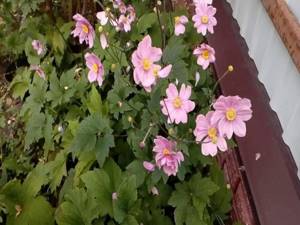
Begonia everblooming
Begonia is characterized by abundant and long-lasting flowering until frost. The compact perennial reaches a height of 20 cm. Its stems are succulent, the leaves are asymmetrical, fleshy, rounded. The color of the plant's foliage varies from green to brown. Begonia flowers are small and numerous. Their shades are varied - white, red, crimson, pink. The perennial looks good in the foreground of the flower bed in combination with verbena, lilies, and roses.
Ever-blooming begonia easily tolerates shade, but can be planted in tree trunks.
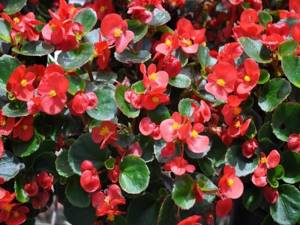
Astilbe
The perennial of the saxifrage family is herbaceous. The height of astilbe is up to 200 cm. The flowers are panicles, 50 cm long. The color of the inflorescences is white, pink, purple, and red. The leaves of the plant are openwork and large. After flowering ends, a fruit is formed in the form of a capsule with seeds. Flowering continues all summer. The plant feels best in sparse shade; it does not require much light to grow. Soil with high groundwater is the optimal place for a perennial that does not tolerate drought well.
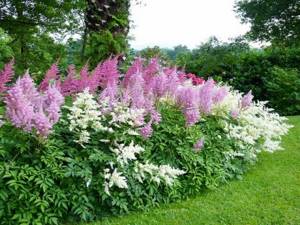
Primrose
Primroses are perennial flowers that grow equally well in shade and partial shade. They belong to the primroses that appear immediately after the snow melts. The first to emerge are the wrinkled, downy leaves. They are collected in a rosette, the stems of the plant are bare. Buds bloom at the ends of the shoots. The culture loves moist places located in the shade under trees and shrubs. It feels good near bodies of water, so the perennial can be used to decorate the shore. It goes well and gets along with hosta, astilbe, fern, daffodils, and tulips. It also looks stylish in combination with deciduous and coniferous shrubs.
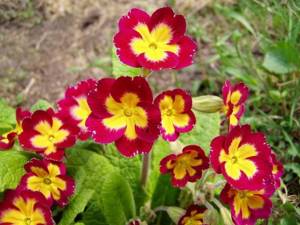
Lungwort
Lungwort is a perennial for shady places, the flowers of which have the ability to gradually change their color from pink to purple. The plant is unpretentious in care and lighting, loves shade, and direct sunlight is destructive for it.
The stalk of the lungwort is low (30 cm), covered with a fluff of hairs. The basal and stem leaves are velvety, with white specks. The perennial flowers secrete sweet nectar, which is how the plant got its name. Despite its moisture resistance, the crop grows poorly in wetlands and requires a high bed. The best place is in the shade of trees and bushes.
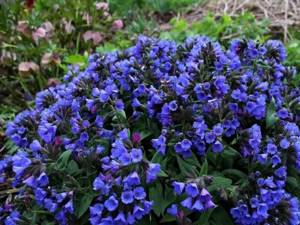
Periwinkle
Periwinkle is a herbaceous perennial. Its small shoots spread along the ground and produce erect flower stalks. The leaves of the plant are elliptical, 5 cm long, 2 cm wide. Blue-violet flowers have a diameter of 3 cm.
Periwinkle grows well in the shade and partial shade of trees. The perennial does not require special care and is unpretentious in propagation, which is carried out by cuttings or dividing the bush.
Periwinkle flowering is short-lived - about one and a half weeks. The decorative effect of the bush remains the whole season thanks to its green foliage, forming a continuous carpet in the shade of the trees.
The garden plant is a shade-loving perennial, so gardeners often use it for rock gardens, borders, designing ponds, and creating decorative curtains.

Siberian iris (Sibirica iris)
Siberian iris is a herbaceous perennial that can grow both in sunny places and in the dense shade of trees. If there is insufficient lighting, irises are not able to bloom. They are not afraid of winds and drafts, and never lie down. Their sword-shaped leaves of all shades of green look decorative. The stems of the iris are strong, branched, up to 1.2 m high. The flowers of the plant are six-parted, most often violet-blue. The white rhizomes of the perennial are located close to the surface of the earth. Iris flowering begins in May-July.
Attention! You can grow an iris flower in one place for up to five years.
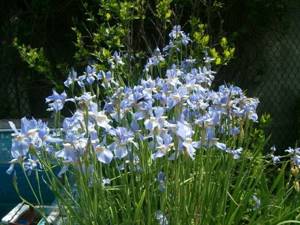
Lily of the valley
Among shade-loving perennials that bloom all summer, lily of the valley occupies a special place. It belongs to herbaceous plants with a creeping rhizome, having no more than three basal leaves, snow-white, bell-shaped, round flowers. The culture blooms in May-June.
In plantings in the shade of trees, flowers, leaves, and bright red fruits look decorative.
Lily of the valley prefers sandy soils. When growing it in garden plots, you must remember that this perennial is a poisonous plant.
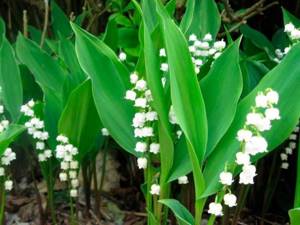
Dicentra
The shade-tolerant perennial is better known as "broken heart." Its height is about 80 cm. Its root system is taprooted, with very few lateral branches. The dicentra grows upward, not wide. The leaves of the plant are openwork, with jagged edges, giving the bush a decorative appearance even after flowering has ended, which lasts from June to September. The perennial inflorescences are similar in shape to hearts, evenly distributed along the entire length of the shoots.
When planted in the shade, under trees, dicentra blooms later than usual, but with a lack of lighting, the flowers become brighter.
Important! The crop loves moisture, but its root system suffers from waterlogging.
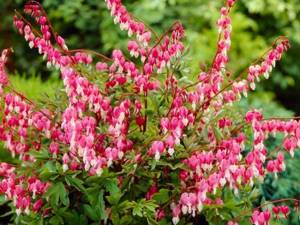
Kupena
The perennial kupena belongs to the Asparagus family. It has thick, shallow roots, oval and lanceolate leaves, and arched shoots. The branches of the crop are strong and do not die from rain. As you can see in the photo, shade-loving perennial garden flowers look especially impressive during flowering. During this period, white flowers appear on long shoots, hanging like earrings and resembling lilies of the valley. The height of plants depends on the species, it can be from 10 to 150 cm.
Flowering of the kupena continues for five weeks, starting in May. The perennial is not picky about soil; it grows and blooms ideally in the shade on fertile soil. Prefers close groundwater, but does not like waterlogging.
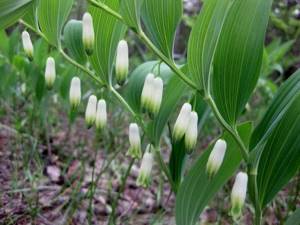
Shade-tolerant berry bushes
Such perennial plants are suitable for those gardeners and summer residents who want the plants they grow to be not only very beautiful, but also to bring certain benefits.
Barberry
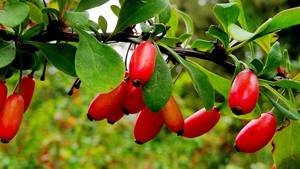
This shrub is quite popular in eastern countries. It is fast-growing and frost-resistant. It is quite easy to care for and also tolerates dry periods very well. This shrub has small, very beautiful leaf blades, which in the fall change their green color to rich burgundy. Barberry produces berries that have high taste qualities. They are used in cooking to prepare a variety of dishes.
Currant
Currant bushes can not only be grown in shady areas, but are even necessary, since a bush planted in the sun in the southern regions will burn. Currants love shade, as in the wild they grow in fairly dark and swampy areas.
In partial shade, large and sweet red currant berries will grow on the bush, but they will ripen a little slower than on bushes planted in a well-lit place in central Russia.
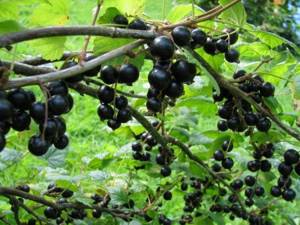
Kalina
Light-loving viburnum shrubs can be grown in partial shade, as they will not die from lack of light. However, lack of sufficient sunlight will cause the volume of crops on the branches to decrease.
This is interesting: Pruning barberry: how to trim to form a crown
In a shaded area, viburnum will turn from a fruitful plant into a decorative one.
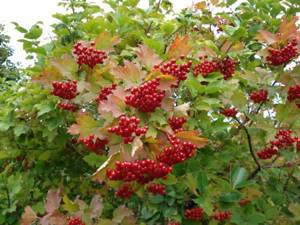
Gooseberry
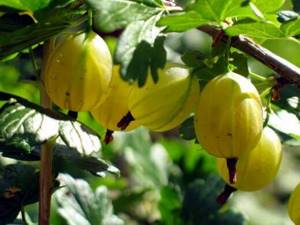
It can grow in both sunny and shaded places. And such a shrub needs to be watered quite rarely and moderately, and it can withstand a dry period. The plant produces very tasty berries, which are often used to make jam.
Blackberry
The blackberry bush can be planted in the shade of a tree or fence; it is unpretentious in relation to sunlight, but requires good watering.
If you water the blackberries abundantly after planting and fertilize the soil with organic substances, such as pine ash, the bush will produce a large number of fruits.
Shade-grown blackberries will ripen slightly later than sun-grown blackberries, but the size and flavor of sun and shade berries will be the same.
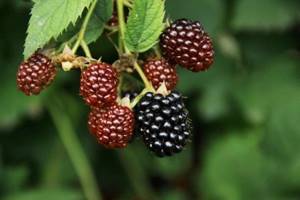
Rose hip
In addition to the fact that rosehip blooms beautifully, its fruits are very beneficial for health. You can plant shrubs in shady areas of the garden, as they easily adapt to low amounts of sunlight.
Note: during flowering, rose hips attract bumblebees to the site, which are an important part of the ecosystem and are useful for the garden and greenhouses.
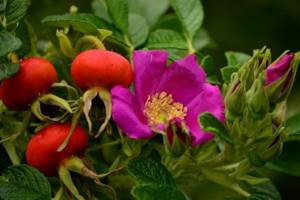
Raspberries
The raspberry bush grows well and bears fruit in poorly lit areas of the garden or vegetable garden. It can be planted along the fence, in the shade of grapes or fruit trees.
Raspberries ripened in the shade are juicier, larger and sweeter than those grown in a well-lit place.
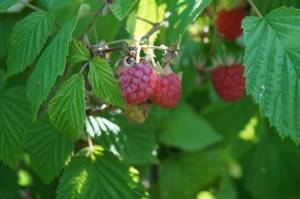
Hazel
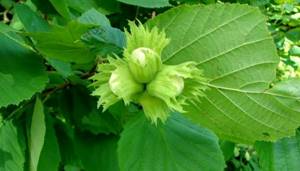
This plant prefers to grow only in non-acidic soil. If the soil is acidic, then it is recommended to add sand to it. Quite tasty nuts grow on hazel.
Decorative foliage plants for shade and partial shade
It is difficult to create a harmonious composition in the shade of a garden without the use of decorative deciduous perennials. Many of them are shade-loving, distinguished by bright original foliage. Breeders have recently paid much attention to the emergence of new varieties with unusual foliage shapes and interesting colors. Even with inconspicuous flowering, they successfully fulfill their decorative function. These include deciduous plants, coniferous shrubs, and vines. In combination with flowering perennials for shade, it is possible to create compositions that are harmonious and impeccable in style.
Khosta
For landscaping a shady garden, hosta is a real find. For this purpose, the plant is used by both amateur gardeners and professional landscape designers. Even in the strongest shade it thrives, its foliage is bright and powerful.
Hosta belongs to the Liliaceae family. The perennial is a low, dense bush made up of leaves. Its rhizomes are thickened with thread-like branches. Funnel-shaped hosta flowers are found on tall peduncles. Their shades change from white to purple. The leaves of different hosta species differ in size and color. They can have stripes and strokes of different colors - white, yellow. The best place to plant the plant is at the edges of a pond or on the bank of a pond with deep shade. It can grow in one place for up to 20 years.
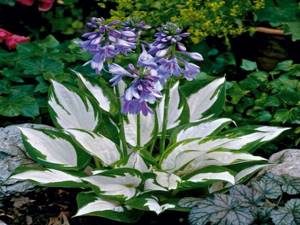
Fern
Ferns are perennials that easily tolerate shade. They only need 2 hours of diffused sunlight at sunset or sunrise. Plants are more demanding when it comes to soil; they prefer moisture-intensive soils rich in organic matter. The best place for planting is where the snow melts later than everyone else, since this perennial is afraid of frost. The size of the fern depends on the type of plant, ranging from dwarf varieties to giant ones. Its root is small, its stem is dense.
Attention! What are commonly called leaves are actually fronds, leaf-like organs formed from buds in the rhizome.
Ferns are combined in plantings with galanthus, scillas, corydalis, and wild garlic.
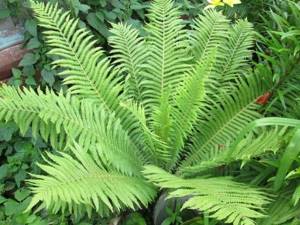
Tenacious
Tenacious is one of the easiest perennials to care for. Feels great among stones, in dense shade, in the tree trunks of deciduous trees and shrubs. The height of the plant is only 15 cm, so it is used for borders and the front line of flower beds. The tenacious plant grows very quickly in the shade, taking root with creeping shoots and covering large areas with foliage. The culture has erect peduncles on which blue, pink, white, and blue flowers are located.
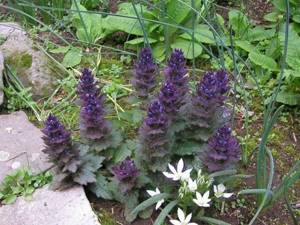
Cuff
This perennial herbaceous plant has a creeping stem that rises during flowering. Its root is thick and located horizontally. Plant height is 30 cm. The basal leaves are slightly wavy, the stem leaves are semicircular and pubescent. The cuff has the ability to retain morning dew in each leaf. Flowering occurs twice a year - in June and September. Paniculate inflorescences of greenish color have the shape of balls. This perennial thrives in the shade, in damp places in the garden.
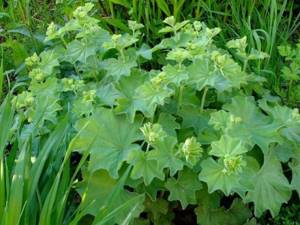
Kopyten
Due to its modest appearance, this herbaceous plant is not often used in garden decoration. Its flowers are so invisible that it is not so easy to see them. The perennial got its name because of the shape of the foliage: each leaf resembles a horse’s hoof; it is round, leathery, and bright green. A plant that lives in the shade of the forest remains green all year round. The height of the perennial is 15 cm. The shoots of the hoofweed are creeping and rooting. Inconspicuous flowers appear in May, hiding under the leaves. In the wild, the hoofweed grows under the forest canopy; in the garden, its favorite place is the shade of trees. It goes well with hostas, ferns, and conifers.
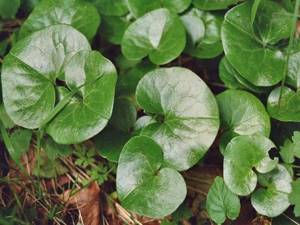
Garden jasmine:
Quite a popular option when choosing a shade-loving shrub for the garden, among perennial plants. Jasmine is famous primarily for its beauty; it can become a real highlight of your site. Its beauty is especially captivating during the flowering period; in addition, it emits a pleasant and incomparable aroma.
You will also like the unpretentiousness of jasmine; it is not picky about the soil or the planting site, whether it is a sunny area or not. It is also resistant to environmental conditions, withstanding hot, dry months in summer and cold in winter. But garden jasmine requires constant and systematic pruning.
Jasmine pruning:
To ensure a well-groomed crown, you cannot do without formative trimmings to ensure they are successful, follow the recommendations from experienced gardeners:
- It is best to form a bush in the spring, before the growing season begins;
- The longest branches are removed completely, the rest are cut to one-half their length;
- To make the bush bloom more abundantly, cut off all empty branches;
- An adult plant needs pruning of the central trunk, it is cut to about 45 centimeters, all others are cut off completely;
- Carry out sanitary pruning, removing old, damaged branches and shoots.
Shelter for the winter:
Although this plant is not very afraid of cold weather, it is still better to cover it for the winter, because if there is no snowy weather, any shrub can die, especially for young plants; with older plants, such procedures may not be necessary for residents with a temperate climate.
- Jasmine should be covered after flowering; for this, use special material, or ordinary straw.
- To protect the roots, you need to dig up the tree trunk circle in the fall and add compost to it.
Reproduction:
This process occurs in four main ways:
- Seeds - you can sow them immediately in open ground, or grow seedlings at home.
- By cuttings - cut the cuttings at the very beginning of summer, then transplant them into open ground or into a greenhouse.
- By shoots - they are separated from the mother in the spring. Select the strongest and most viable specimens; they should overwinter indoors, and in the spring, transplant them to a permanent location.
- By dividing the root - the root is divided in the fall; this method is not very practical and is used extremely rarely.
Creepers for shade
If vertical gardening is necessary in a poorly lit corner of the garden, shade-tolerant vines are used. For a perennial plant, you will need a strong support, which can be a fence, tree, arch, or gazebo. Climbing plants are most often used for planting in the shade:
- Kirkazon;

- Wood pliers;
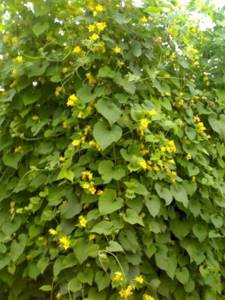
- Maiden grapes;
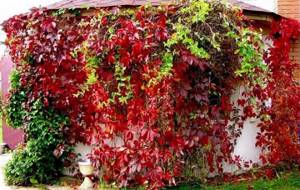
- Princes;
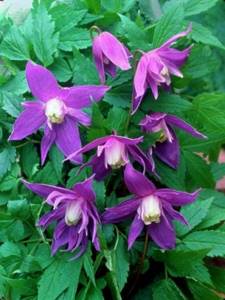
- Chinese lemongrass;
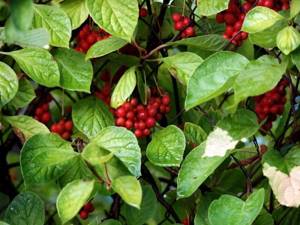
- Hop.
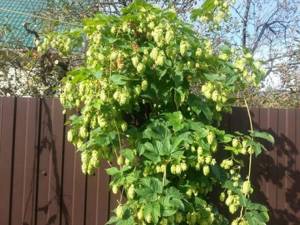
Ideas for decorating a flower bed in the shade
There are several secrets when composing compositions in the shade:
- deciduous plants of silver color are combined with perennials with blue flowers;
- in the center of the composition it is better to use contrasting combinations of shades; in the depths of the garden they should be softer;
- excessive variegation of perennial leaves brings chaos to the design of a flower bed in the shade of trees;
- a combination of leaf shapes in contrast is necessary - long, curved ones look good with rounded, heart-shaped ones.

